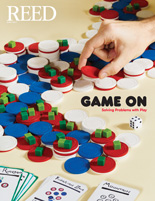
IRIS login | Reed College home Volume 96, No. 2: June 2017
Bio Profs Win NSF Grant to Study Shapeshifting Cells

SHAPING A CELL. This S2R+ cell expresses fluorescently labeled actin and fluorescently labeled NMII, imaged by total internal reflection microscopy.
Your gastrointestinal tract may not seem like the most exciting part of your physical identity, but it is one of the most vital. Virtually every creature on earth, from the ant to the elephant, is built on a similar plan, organized around a tube that eats at one end and excretes from the other. But how does this majestic triumph of evolution actually take shape?
The way an organism takes shape—known as morphogenesis—remains one of the central puzzles of biology. Now two Reed scientists, Prof. Derek Applewhite [biology] and Prof. Anna Ritz [biology], have won a $589,000 grant from the National Science Foundation to lead a project investigating the mysterious signalling system that turns a blob of cytoplasm into a stomach or a spinal cord.

Prof. Derek Applewhite and Prof. Anna Ritz won a $589K grant from the NSF to study the signalling system that controls the shape of a cell.
The Reed project will focus on non-muscle myosin II (NMII), a key protein that governs the shape of a cell. The researchers are seeking to better understand the sophisticated chain of command that switches NMII off and on. This chain begins with the architectural blueprints encoded in a cell’s DNA and ultimately generates the microscopic filaments that change the cell’s shape. For example, NMII triggers a process known as apical constriction, which turns round cells into wedge-shaped cells, beginning the process that will form the tubular formations that become spinal cords and guts.
“This is a fundamental process that takes place in practically every multicellular organism,” says Prof. Applewhite. “We understand a lot about it—but there’s so much that we don’t know.”
The Reed researchers have already identified a protein previously not thought to play a role in triggering NMII. But they also know that it does not act in isolation. Many other proteins—as yet unknown—are involved in the process. To find them, the researchers will borrow some ideas from graph theory, a branch of mathematics that describes how proteins can influence each other in the cell. Prof. Ritz and students in her class in computational systems biology will develop algorithms to identify likely proteins. Prof. Applewhite and students in his class in cellular biology will then test those proteins using a combination of RNAi depletion and phase-contrast microscopy to see if they do indeed shift the shape of fruit-fly cells.
“Some predictions will work, some won’t,” says Prof. Ritz. “Then we’ll refine the algorithm and run it again.”
The Reed scientists hope the project will begin to identify the “whole symphony” of proteins involved in regulating NMII, says Prof. Ritz.
The project will last four years and involve roughly 40-50 students annually.


LATEST COMMENTS
steve-jobs-1976 I knew Steve Jobs when he was on the second floor of Quincy. (Fall...
Utnapishtim - 2 weeks ago
Prof. Mason Drukman [political science 1964–70] This is gold, pure gold. God bless, Prof. Drukman.
puredog - 1 month ago
virginia-davis-1965 Such a good friend & compatriot in the day of Satyricon...
czarchasm - 4 months ago
John Peara Baba 1990 John died of a broken heart from losing his mom and then his...
kodachrome - 7 months ago
Carol Sawyer 1962 Who wrote this obit? I'm writing something about Carol Sawyer...
MsLaurie Pepper - 8 months ago
William W. Wissman MAT 1969 ...and THREE sisters. Sabra, the oldest, Mary, the middle, and...
riclf - 10 months ago